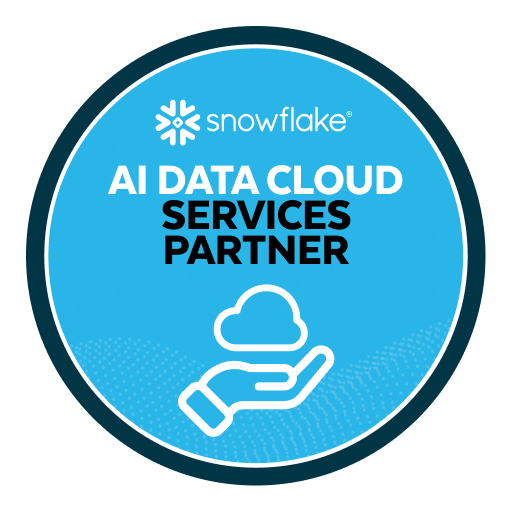From legacy to lakehouse: Practical migration strategies with Databricks and Snowflake
Businesses are increasingly turning to AI-powered cloud analytics tools to gain a competitive edge in today’s data-driven world. According to research from Goldman Sachs, the cloud computing market is expected to rise to $2 trillion by 2030, with generative AI comprising up to $300 billion of overall cloud spend.
Tools like Databricks and Snowflake are leading these transformations, offering robust platforms that enable data processing, analysis and decision-making capabilities. These tools enable organizations to harness the power of artificial intelligence and machine learning to solve complex business challenges and drive innovation.
This article explores how AI-powered cloud analytics tools like Databricks and Snowflake are transforming industries. Our experts provide actionable strategies for implementation, migration and optimization.
Whether you’re modernizing legacy systems or building a next-gen data platform from scratch, Kforce Consulting Solutions can help align technology to your strategic goals. Connect with our experts to discuss a custom AI-powered cloud analytics strategy.
This Ruler is for the Space Between the Bottom of the Hero/Header Text and the
Subheader Copy. Check Your Spacing for Consistency.








Unlocking AI and analytics value with modern cloud data platforms

Contact us
Contact us
Ready to unlock the full potential of Databricks or Snowflake?
Together Toward Tomorrow

Together Toward Tomorrow



Industry applications�of AI cloud analytics tools
Databricks, Snowflake and similar tools offer invaluable benefits across various industries, such as enhancing data processing and analysis capabilities and improving decision-making and real-time data insights. Here is a look at common industry-specific use cases:
How advanced analytics and AI can save our grid from electric vehicle overload

How advanced analytics and AI can save our grid from electric vehicle overload
Success story: Using AI to enhance operational outcomes

Success story: Using AI to enhance operational outcomes
Whitepaper: Preparing your organization for generative AI

Whitepaper: Preparing your organization for generative AI
Related articles
Contact us
Contact us
Discover the power of partnership



Finance
Databricks and Snowflake can process and analyze large sets of transaction data in real-time. These platforms enable the deployment of anomaly detection models to find unusual patterns and flag suspicious activity as it happens, significantly improving fraud prevention efforts. Predictive analytics are also being used to analyze historical data and customer profiles. This improves credit risk assessments, reduces inherent decisioning bias and enables cross-selling based on transaction history.
Real-time fraud detection and risk management
Insurance
Smarter underwriting and claims automation
Insurance companies are using platforms such as Databricks and Snowflake to enhance efficiency and customer experience. Predictive analytics allow insurers to conduct more accurate risk assessments and optimize their pricing strategies, resulting in more efficient underwriting processes. Agentic AI capabilities built on these platforms are also used to automate claims validation, speeding up the claims process and enhancing the overall customer experience by delivering faster resolutions.
Energy
Demand forecasting and grid optimization
Energy companies are using real-time analytics to better understand and manage consumption patterns. By forecasting energy demand, utilities can optimize grid performance and ensure more reliable service delivery. Predictive maintenance models help identify potential equipment failures, reducing downtime and minimizing customer outages. Databricks’ real-time processing capabilities are particularly valuable in this context.
Retail
Hyper-personalized customer engagement and supply chain resilience
Retailers are using AI cloud analytics to deliver highly personalized customer experiences. By analyzing behavioral data, they can segment customers into distinct target groups to deliver personalized marketing campaigns and product recommendations. This segmentation increases engagement and conversion rates. Snowflake’s data sharing capabilities further enhance this personalization by enabling retailers to collaborate with partners and integrate external data sources, creating a more holistic view of the customer journey.
Companies also use these tools to build more resilient and efficient supply chains. These platforms allow companies to integrate data from suppliers, production lines and distribution networks, providing a comprehensive view of operations. By analyzing this data, they can find bottlenecks, predict equipment failures and improve inventory management. Snowflake’s Data Cloud enables this integration, supporting smarter logistics and more agile decision-making across the supply chain.
Healthcare
Predictive care and operational efficiency
Healthcare providers use AI analytics to improve patient treatment plans and outcomes. Predictive models help identify potential disease outbreaks and flag high-risk patients, enabling earlier interventions. Databricks and Snowflake also support more efficient claims processing and care coordination. The ability to analyze large, complex datasets in real time is helping healthcare organizations move toward more personalized care models.

Maximizing investments in Databricks and Snowflake
“Organizations considering platforms like Databricks and Snowflake typically fall into one of three implementation categories—each with their own unique strategies for success. Whether you’re migrating from legacy systems or building a new platform from the ground up, aligning your approach with your business goals is key to unlocking long-term value.”
�– Brad Boyd�VP Consulting Solutions, Data & AI
Legacy migration (lift-and-shift)
The lift-and-shift approach focuses on minimizing business disruptions by recreating existing workflows, schemas, pipelines and reports with minimal changes.
This strategy is often chosen to reduce the time to go-live while also minimizing migration costs and disruptions to existing business operations. This approach provides a solid foundation for a modern data platform. However, it may accumulate technical debt at a greater rate than the other approaches.


Connect with me

Brad Boyd
MEET THE AUTHOR
VP CONSULTING SOLUTIONS
DATA & AI
Key strategies for lift-and-shift migrations
Conduct a comprehensive system inventory�Catalog all ETL jobs, data models, reports and pipelines from the legacy system. Use automated discovery tools (e.g., lineage scanners) where possible. This ensures accuracy and minimizes the risk of rework and delayed deployments.
Compatibility mapping�Map legacy functions to their equivalent features in Databricks and Snowflake. Understanding how the legacy platform’s capabilities translate into Databricks’ (e.g., notebooks, ML pipelines and Spark jobs) or Snowflake (e.g., stored procedures, views and UDFs) is crucial to this scenario’s migration strategy.
Adopt a layered migration approach�Migrate data in stages—raw > transformed > presentation. Use Snowflake staging zones or Databricks’ Medallion architecture (bronze, silver, gold) to organize data and replicate legacy stages.
Legacy migration (lift-and-shift)
1. System inventory
2. Compatability mapping
3. Layered migration
Legacy migration with rearchitecture
1. Data rationalization
2. Modern ELT/ETL
3. Business alignment
4. Cloud-native governance
Key strategies for legacy migrations with rearchitecture
Rationalize your data�Migrate only what is necessary. Streamlining data and structures reduces technical debt and improves the performance of underlying semantic layers.
Modernize your ELT and ETL frameworks�Use tools like dbt, Fivetran and Airflow to build scalable, maintainable pipelines.
Align with business use cases�Design the new data platform architecture around current and emerging analytics needs, not outdated legacy requirements or structures.
Implement cloud-native governance�Use a modern data governance approach such as Unity Catalog with Databricks or Snowflake’s governance features (e.g., object tagging, row-level security) to ensure secure, scalable data management.
Legacy migration with rearchitecture
The migrate and rearchitect approach combines the business alignment of legacy systems with the performance and scalability of the modern data platform. This approach is ideal for companies that are ready to redesign their data architecture while preserving core business logic.
Greenfield implementation
1. Platform fit analysis
2. Design principles
3. Modular architecture
4. Infrastructure as code
5. Data observability
6. Change management
Key strategies for greenfield implementations
Determine design principles�Choose a foundational architecture—data mesh, data lakehouse or data fabric—based on your business objectives.
Build a modular data architecture�Establish standardized zones or layers (e.g., raw, curated, modeled) and automate ingestion and transformation pipelines.
Use infrastructure as code�Deploy infrastructure using Terraform, Azure Resource Manager or AWS CloudFormation. Implement CI/CD pipelines for data jobs and models to support agile development and testing processes.
Ensure data quality and observability�Integrate tools such as Great Expectations, Monte Carlo or Datadog and establish data-related SLAs, contracts and lineage tracking to increase data confidence and visibility.
Invest in change management�Stand up a Center of Excellence to drive adoption, provide hands-on training and maintain documentation and data catalogs for long-term success.
Greenfield deployments
For organizations starting from scratch, a greenfield deployment offers the opportunity to build a modern, scalable data platform tailored to current business goals. When using this approach, a platform fit analysis is critical to determine whether Databricks or Snowflake is the better match. Databricks is ideal for advanced analytics, machine learning and streaming workloads while Snowflake excels in SQL-first analytics, ease of use and secure data sharing.





SPACE IN BETWEEN MODULES/ Macros/ Sections
SPACE IN BETWEEN HEADER AND SUBHEAD + Subhead & Body




published June 2025
Businesses are increasingly turning to AI-powered cloud analytics tools to gain a competitive edge in today’s data-driven world. According to research from Goldman Sachs, the cloud computing market is expected to rise to $2 trillion by 2030, with generative AI comprising up to $300 billion of overall cloud spend.
Tools like Databricks and Snowflake are leading these transformations, offering robust platforms that enable data processing, analysis and decision-making capabilities. These tools enable organizations to harness the power of artificial intelligence and machine learning to solve complex business challenges and drive innovation.
This article explores how AI-powered cloud analytics tools like Databricks and Snowflake are transforming industries. Our experts provide actionable strategies for implementation, migration and optimization.
Healthcare industry: Building a world-class intranet in a new CMS

Kforce develops API modernization tactical roadmap

Technology industry: Streamlining data asset management within AEM

Related stories
Goldman Sachs
optimize grid performance


This Ruler is for the Space Between Text/Buttons/Callouts. Check Your Spacing for Consistency.

